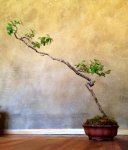Velodog2
Chumono
......but I'd say no, not bunjin
Ohhhhhh ... I dunno. This one could be debated endlessly, but it's more bunjin to me than anything else. A little slight curve or two would help perhaps, and maybe a more typical pot style (although I love the one it's in), or maybe even a little less foliage. But getting back to the "feels", this feels bunjin. And it meets my negative space ratio criteria ...
That elusive deciduous literati to me is not particularly old or tortured but is represented better by the understory tree at the edge of a wood that slants out and up trying to escape the overshadowing of its taller neighbors. They are represented most often here in Maryland by Redbuds, or sometimes Dogwoods. I looooove those trees! And this one too. So elegant. They are literati to me.








